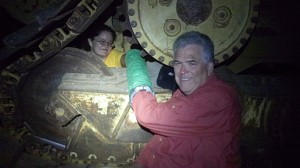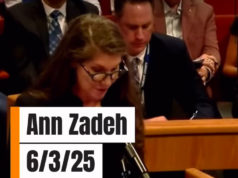Probably the most frequently used argument in favor of the Keystone XL project is the jobs it’s supposed to bring to the United States. TransCanada hired The Perryman Group, an economic and financial analysis firm from Waco, to evaluate the project’s jobs potential. That report, released in 2010, estimated that the construction and associated development of the pipeline would produce more than 118,000 “person years” of direct employment and create as many as 250,000 spin-off jobs, which researchers said included bakers, bartenders, clergy, dancers, dentists, and hairdressers, who would be needed to take care of the pipeline workers.
The report became a call to arms to get Obama and the State Department to allow the XL portion of the pipeline to cross the border. The U.S. Chamber of Commerce claimed the project would create more than 250,000 permanent jobs in the States. Texas’ U.S. Sen. Kay Bailey Hutchison announced on the Senate floor that the president needed to sign off on the project because it “promises 20,000 immediate jobs and 118,000 spin-off jobs.” Even Republican presidential hopeful John Huntsman repeated the 118,000 jobs figure.

But that figure was a misunderstanding of the 118,000 person-years of work the Perryman group had extrapolated. A “person year of work” is not a permanent position, and even a senior vice president at TransCanada put the number of permanent American jobs, once the pipeline was completed, at roughly the number of people employed by one or two Wal-Mart stores — several hundred people at best.
Still, the promise of tens of thousands of well-paying manufacturing and construction jobs — even if they were temporary — seemed to many like the sort of boost needed to get the economy back on track. But those numbers, too, turned out to be inflated: TransCanada, as it turned out, had already signed contracts with firms in India and Canada to manufacture about half the amount of pipe that would be used in the line. The U.S. Department of Labor estimated that the pipeline project would create about 6,000 to 7,000 jobs and that most of those would last only six to nine months.
TransCanada spokesman David Dobson, in an e-mail to Fort Worth Weekly, wrote that for both the Keystone XL and the Gulf Coast Project — the connecting line between Houston and Port Arthur — “the overwhelming majority of the pipe … will come from highly specialized North American mills.” However, North America includes Canada, and in a follow-up phone call, Dobson confirmed that “about half the pipe will be manufactured in the U.S.”
Then there was the promise of hundreds of thousands of barrels of oil being turned into gasoline that would substantially lower the price at the pump for Americans. Environmental groups and U.S. Rep. Ed Markey of Massachusetts, the ranking Democrat on the House Natural Resources Committee, noted that the final destination for the XL is Port Arthur, a foreign-trade zone that allows tax-free transactions with other countries. The tar sands currently entering the U.S. are being refined and utilized here, but opponents say that will not be the case with product shipped to the Gulf Coast.
“The refineries in Houston, with the connection to the foreign trade port, make this clear, that the Keystone XL is an export pipeline,” said Kate Colarulli, associate director of Sierra Club’s Beyond Oil campaign.
Markey suggested that TransCanada’s real point of destination for the tar sands oil is Asia. TransCanada’s president for energy and oil pipelines Alex Pourbaix, denied that at a congressional hearing in December 2011, saying, “The most important role that Keystone will play is to bring energy security to the United States.”
Markey then asked Pourbaix if he could promise that all of the diesel and oil products made from the Keystone XL tar sands would be sold in this country.
“No, I can’t do that,” Pourbaix responded.
********
Among those arrested in front of the White House in 2011 was Julia Trigg Crawford (“Your Land is My Land,” April 11, 2012). Crawford is the manager of her family’s 650-acre Red’Arc farm that runs along the Bois d’Arc Creek and the Red River not far from Paris, in northeast Texas. Crawford had been approached by representatives of TransCanada in 2008 for permission to run a pipeline along a 40-acre pasture on one end of the property. When she and her family turned down the proposal, TransCanada upped the financial offer a couple of times, then eventually condemned the land it wanted via eminent domain in September 2011, not long after Crawford’s arrest.
Crawford, with the help of others, soon discovered that TransCanada had been involved with at least 89 land condemnations in Texas and had threatened hundreds of others with eminent domain before the company even had the permits necessary to build the pipeline.
She was incensed. TransCanada had the right to acquire land by eminent domain only if the company could prove that its pipeline was a “common carrier,” which means the company would sell capacity on the line to other companies to carry their petroleum as well as TransCanada’s own. If TransCanada was a private carrier, carrying only its own petroleum products, it wouldn’t have the right to take land through eminent domain in Texas. TransCanada had never produced information making good on its common-carrier claims, so Crawford and her family sued the company on those grounds.
While the lawsuit was playing out, Obama turned down TransCanada’s request to allow the XL pipeline to cross the U.S.-Canada border. The company vowed to develop a different route and reapply, but the setback didn’t stop TransCanada from continuing to take and threaten to take land by eminent domain, particularly in Oklahoma and Texas.
The company’s confidence lay in the fact that since the southern leg of the pipeline would be entirely within this country, no State Department approval was necessary. All that was necessary was to get the green light from the U.S. Army Corps of Engineers certifying that certain ecosystems, notably wetlands and waterways, would be reasonably protected.
Opponents of the line regarded the Crawford lawsuit as one of the final legal obstacles that could stop the Keystone XL. It became an even more important issue when Obama, on March 22, told federal agencies that he wanted them “to cut through the red tape” on the southern leg of the XL, “and make this project a priority.”
If the Crawford lawsuit could stop TransCanada from taking land through eminent domain, the project might have to shut down. However, on Aug. 22, Lamar County Court at Law Judge Bill Harris ruled against Crawford — in a 15-word text message delivered from his iPhone.
The entire text of the message was:
“TransCanada’s MSJ [motion for summary judgment] GRANTED.
TransCanada’s NEMSJ [no evidence MSJ] GRANTED.
Crawford’s Plea to the Jurisdiction is DENIED.”
The decision meant the judge was taking TransCanada’s word that the Keystone XL pipeline would be a common carrier, although the company had presented no evidence to back up that assertion.
Crawford immediately began working on a possible appeal, but TransCanada wasted no time in taking advantage of the ruling. The company began felling trees and clearing land along the pipeline route from Oklahoma to the Gulf Coast. And a small group of anti-pipeline protesters figured it was time for their first major direct action in Texas.
********












These young protestors are American patriots. It is pathetic that a foreign corporation would be allowed to rip out our trees so they can make a profit.
Solidarity! Prayers for those in harms way.
Cold, wet and dreary? Sounds like they could use a little global warming about now.
It was reported that 10 or 11 people in one mobil home park near the Kalamazoo Michigan spill are now dead and only one of them was a senior citizen. PLease watch this video… http://www.youtube.com/watch?v=XrFep4IJ6lY made by John Bolenbaugh.
Great story, Peter. I will save some good wishes for the tree sitters tonight. They are braver than I am.
Who is leading the charge in oil sands development? Canadians, and Chinese state-owned enterprises giving them billions. Economic henchmen at work here in the U.S.
China’s energy influence in Canada: http://business.financialpost.com/2012/05/10/industry-quiet-as-public-concern-grows-over-chinas-energy-influence-in-canada/
At least some people are paying attention.
There’s nothing in east Texas. So now they truck it in with fuel burning trucks, crowding the highways, or I guess we just keep relying on Saudi or Venezuelan oil. Article seems a little biased. How would you fix the problem?
The U.S. does not make gasoline from Saudi oil. Just as a point of interest most of the oil in the middle east is what we make tar, computers, roads, and plastic tables with. To refine it into gasoline, you wind up paying what Europeans pay for gasoline: $8-11 dollars a gallon. So we have never depended on that oil for gasoline. Our gasoline comes from the Permian basin, from Pennsylvania, from Canada, from Mexico, from Venezuela–except for Pennsylvania, pretty much a straight line down the east side of the Rocky Mountains into South America.
So I”m not sure what your point is. Thus far, no jobs have been created for anyone not already working. And there will not be. The oil, as most people suggest, has probably already been contracted to China. It will flow through a port that requires no taxes to be paid to the U.S. So if there are no new jobs–just a few hundred for people already working–no taxes, and no oil coming to stay in the U.S., then what exactly is the point of this pipeline? I tried to find that out while doing this story but did not get any answers from the oil/pipeline/refineries involved in this. I’m more than willing to be taught the other side because unbiased journalism is what journalists strive for. But if the other side won’t tell it’s story, well, then maybe an article will seem biased. But that is very very very far from the truth.
Thank you for Peter for a fabulous, deep and well-written piece of investigative journalism on a story, and issue, which is both ignored by the mainstream, and is also an immensely important one. Many layers as well..which have have laid out as well as any other I have seen in my considerable study of the Keystone Pipeline issue. I hope this piece gets HUGE wide coverage (you deserve a Pulitzer for this, really) and, more so — you stay on TOP of it. Cheers.
Typo FYI: (…..story which YOU have laid out as well as any other…)
Didn’t you read the article? It is a well know fact that the pipeline is being built to transport Canadian tar sands oil to tax free havens on the gulf with the intent to sell the refined oil to foreign countries, e.g. China, India and South America. This is the intent expressed in TransCanada’s own plans
Americans take all the risk of the pipeline with absolutely no benefit.
Solidarity! We stand with these brave Americans who are trying to protect OUR land from these greedy monsters. Unlike the fat-cats at TransCanada, I won’t be able to afford a fancy bubble to live in when they ruin our planet for good.
Peter and FW Weekly– Thank you for the best and most indepth article I have read on the tarsands and the blockade. I have a family member participating in the protest, at great sacrifice, and now I fully understand why. Well done. It is encouraging to see that journalism is not dead.
Congratulations for this superb article. Everything presented is exactly as I know the facts to be. You have presented your readers with a story that includes a timeline and the all-important side issues that surround this issue. This is story that cannot be reduced to a soundbite, or an often repeated blurb of half-truths surrounding job creation. I wouldn’t worry about TransCanada’s side of the story; it is being told every day by carefully controlled mass media news outlets. Theirs is the only story has been told until now. As we know TransCanada has been interfering with news reporters doing their jobs, even if they are from the New York Times. They attempted to arrest those reporters until they realized who they were. They dropped the made-up arrest charges and let them go but wouldn’t allow them access to blockaders for their story. They did in the end get a story but not nearly as thorough as yours. Thank you from an East Texan.
Great article!!!
I wish all of the media would step up, do their jobs and tell the truth about the devastation of tar sands development and the public dangers of the toxic tar sands pipelines.
You talk about the tar sands oil spill in Michigan two years ago. Watch this video about the toxic content of tar sands pipelines and interviews with people sick and possibly dying because of the spill. It truly saddens my heart. Search for “John Bolenbaugh, Part 1 of 2 COVER UP VIDEO short version” on YouTube.
Just for your information in the future, Eleanor Fairchild did not give up her land. TransCanada’s easement was forced on her in the local court. It is now a question whether the higher courts agree that TransCanada has the right of eminent domain. Supreme courts have ruled against other pipelines. See http://stateimpact.npr.org/texas/2012/08/22/texas-supreme-court-reinforces-denbury-decision-on-eminent-domain-again/
Great article, thanks. I had heard of the protests, but this filled in a lot of the details. We should be proud of these people, taking on the might of foreign corporations.
The citizens of the World have united to fight tyranny both against their government and the domestic terror in the United States known as corporations. What makes you believe that Robust Texans, who a teetering on the edge of Succession to return to its own Republic, would allow a foreign company to intrude onto one of its own? Be very careful. Anyone who tramples of the Rights of the citizen, shall be punished. We are Anonymous. We are Legion. We do not forgive. We do not forget. Expect us.
Mr. Gorman, the tears in my eyes as I write this are not only for the brave humans in the trees, but for YOU, showing that journalism still exists. As this article goes viral (and it is) may you be blessed and protected by the integrity you have brought to this piece and your work, and may your example shine a light for so many other journos to be reminded of the power, value, and need for your profession. Thank you. Bless you. (And great thanks to the editors and publisher too!) With deep love from a Yank ex pat in Sydney Australia.